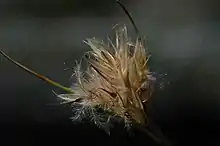| Carpha alpina | |
|---|---|
 | |
| Scientific classification | |
| Kingdom: | Plantae |
| Clade: | Tracheophytes |
| Clade: | Angiosperms |
| Clade: | Monocots |
| Clade: | Commelinids |
| Order: | Poales |
| Family: | Cyperaceae |
| Genus: | Carpha |
| Species: | C. alpina |
| Binomial name | |
| Carpha alpina R.Br. | |
Carpha alpina, commonly known as small flower-rush, is a tufted perennial sedge from the family Cyperaceae. It is found primarily in south-east Australia and both islands of New Zealand, but also in Papua New Guinea. [1]
Description
Carpha alpina grows as a short rhizomatous tufted perennial sedge. [2] It has rigid, striated culms that are glabrous and can grow between 2-10 cm tall and 0.7-1.5 mm wide. [3] The numerous grey-green or red-green leaf-blades are stiff and flattened, with a yellow-brown sheath and a width ranging from 0.5-2 mm. [2] The inflorescence is made up of 1-3 loose clusters ranging from 1-10 cm long with singular or paired bracts slightly longer than the inflorescence. [2] The spikelets are between 8-10 mm long and arranged in clusters of 2-10. [3] The brown, acute and keeling glumes are separated into upper and lower parts, with the lowest 2 or 3 empty and half the size of the upper glumes. [2] The upper glumes are larger - 8-9 mm long, with a bristlelike glume above; the bristles are 7-10 mm long and red or brown in colour. [3] The fruit is a nut, 2.5-3 mm long, brown in colour and narrow-ellipsoid in shape. [4] The nut has a short stipe and is crowned by the rigid smooth or slightly hairy 3-5 mm long style-base. [4]

Distribution and habitat
Carpha alpina is widespread throughout the montane and subalpine areas of Tasmania as well as in mountainous regions of Victoria and New South Wales in Australia.[1] It is also found in New Zealand and Papua New guinea, primarily in mountainous areas. [1] Its habitat includes coastal to alpine bogs, mires, wet alpine and subalpine areas where it can colonize areas disturbed by environmental factors. [3] [4]
Taxonomy
Carpha alpina was first described by Robert Brown after he sailed to Tasmania aboard the Lady Nelson in 1803.[5] It has some resemblance to the grasses of the Rytidosperma genus, however, the flat grey-green or red-green leaves, combined with the lack of lemma and palea on the flowers, and the distinctive stipitate nut; differentiate it from those species. [4]
References
- 1 2 3 Curtis, Winifred (1984). "New Species of Tasmanian Monocotyledons in the families Juncaceae, Centrolepidaceae and Cyperaceae". Brunonia. 7 (2): 297–304. doi:10.1071/BRU9840297.
- 1 2 3 4 "Carpha alpina". VICFLORA. Retrieved 22 March 2020.
- 1 2 3 4 "Carpha alpina". New South Wales Flora Online. PlantNET. Retrieved 22 March 2020.
- 1 2 3 4 "Carpha alpina". New Zealand Plant Conservation Network. Retrieved 22 March 2020.
- ↑ Moore, D.T. (December 2000). "Some aspects of the work of the botanist Robert Brown (1773-1858) in Tasmania in 1804". Tasforests. 12: 126.